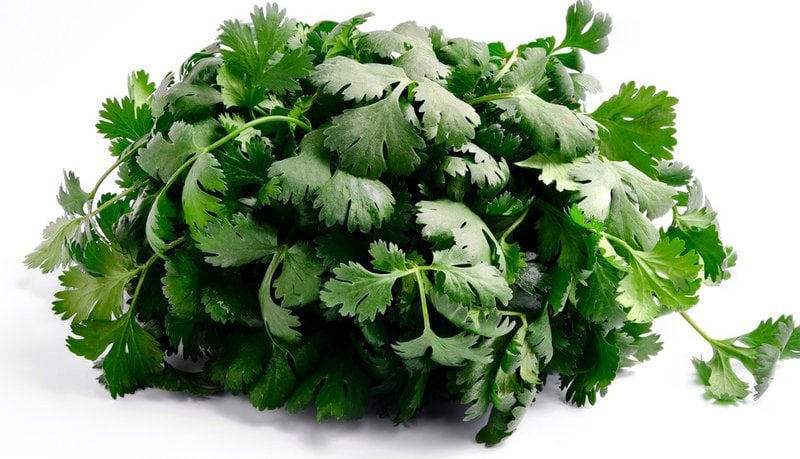When it comes to serving pups unconventional foods like fresh herbs and vegetables, many dog parents are often very hesitant. And yes, you should be because dogs’ digestive tracts are not the same as humans’. Cilantro is fine for humans, but is it okay for dogs to have them, too?
Yes, dogs can have cilantro without any complications to their health or function. In fact, due to its antimicrobial properties, this fresh herb can help dogs steer clear of fungal, bacterial, and viral infections. Cilantro is perfectly alright for all dog breeds so long as they do not manifest allergies having it.
However, this green light brings about cautions you must take and things you ought to know. For instance, how do you serve cilantro to dogs, and what happens when your canine eats cilantro? Keep reading to find answers to these questions and many more.
What Happens If A Dog Eats Cilantro?
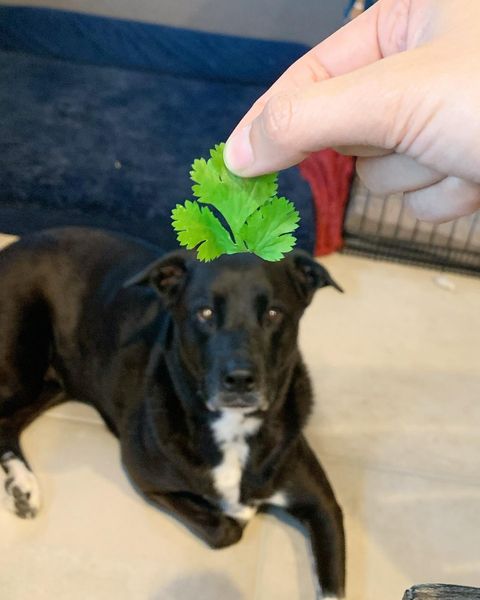
If a dog eats cilantro in moderation, it is less likely to have digestive tract infections, stomach upset, or sleeping disorders. That’s because this Chinese parsley contains antimicrobial agents and essential vitamins needed by your canine for optimum health.
Besides its culinary advantages, such as its appealing flavor and tastes, cilantro also offers several other health benefits to dogs. These health benefits include:
Improved Vision And Stronger Bones
Just a quarter cup of cilantro contains 167 mg of vitamin A and over 15% of the daily vitamin K dietary need of canines. And while vitamin A takes care of the eyes, vitamin K ensures a healthy and strong bone.
So, adding about half a cup of fresh cilantro to your dog’s food means their sight and bones will likely not fail them.
Excellent Way For Dogs To Detox
Like humans, dogs too can accumulate plenty of free radicals in their bodies, courtesy of an unkempt environment or unhealthy food supply.
However, with cilantro in their foods once in a while, it can help get rid of these radicals and other toxic chemicals from the body. So, you can think of cilantro as a natural antioxidant booster for dogs.
Reduces The Risks of Heart Disease
Cilantro aids normal blood flow in dogs, thereby keeping some factors that trigger heart diseases at bay. Dogs feasting on cilantro have decreased risk of coming down with high blood pressure, blood clots, and other serious illnesses.
Fights Off Infections
Perhaps this edible herb’s most outstanding health benefit is its antimicrobial capacities. Various studies have affirmed that cilantro’s essential oil and linalool components can help fight bacterial and fungal infections, especially those associated with the digestive tract.
As such, if your dog has been having digestive problems, you can add a drop of cilantro extract into their water. Alternatively, you can grind the seeds (coriander) and include a small portion in their wet food.
Improves Dogs’ Oral Health
If your canine has bad breath or some gum issues, cilantro has been proven to help combat both. When chewed by canines, the leaves help clean the teeth and release a long-lasting freshness to their oral cavity.
Helps Dogs To Sleep Better
Dogs having problems resting at night have found relief using cilantro. The fresh herbs diced into their food have proven to help elongate pups’ sleeping time and sleep quality.
Gets Rid Of Heavy Metals
Your furry companion might have accumulated heavy metals like mercury and lead into their system. Usually, these things find their way into dogs’ bodies via the food and water taken.
Cilantro helps remove these heavy metals by binding and passing them out through defecation. When out of your pup’s body, many antimicrobial drugs tend to work more effectively.
Wow! That’s a lot of benefits in just a plant! But many people believe that whatever has advantages must surely have disadvantages. Is that true for cilantro? Is cilantro poisonous to dogs? The next section addresses this.
Is Cilantro Poisonous To Dogs?
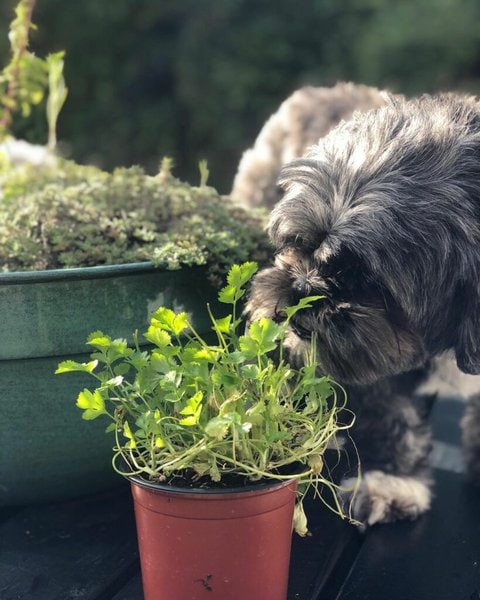
No, cilantro is not poisonous to dogs. The American Society for the Prevention of Cruelty to Animals (ASPCA) says that this plant is safe for dogs, horses, and cats. The only caveat to this is ensuring that your dog is not allergic to plant-based diets.
That’s because dogs that have an aversion to herbs because of their delicate digestive system may experience nausea or stomach upset if fed with coriander. As such, you will have to be sure that your pup doesn’t react to vegetables before you can serve it coriander safely.
Besides, it may interest you to know that coriander doesn’t contain many calories, so it is perfectly alright for dogs with weight issues. There are only about four calories in 0.56 oz of coriander leaves.
That is not to say that all dogs will like this herb. Even without being allergic to it, some dogs may not just like the flavor of this Chinese parsley. Between 4% and 10% of humans don’t like cilantro because they feel it is ‘soapy.’
Humans’ preference or otherwise to this plant is genetic, which can also be true for dogs. That is why you mustn’t force your pup to take this herb if it shows signs that it doesn’t like it.
Since coriander shares a close semblance with parsley, you may also want to know whether both are safe for your dogs. Can dogs eat parsley, too? Find out below.
Can Dogs Eat Parsley And Cilantro?
Yes, dogs can safely eat both parsley and cilantro. Cilantro is Chinese parsley used in cooking globally. But there are other parsleys aside from coriander, although most are perfectly alright for pets.
Most parsleys are very low in calories, high in vitamins and minerals, and medium in fat. But the safest of parsley for dogs is the curly variety.
You will also have to offer your furry friends parsley in moderation, as many of them contain furanocoumarin, which is toxic to dogs when consumed in high quantities.
Nonetheless, healthy foods have to be served in moderation. Both coriander and parsley are not exempted. But the question you may want to ask is: How much cilantro can my dog eat. We will consider this next.
How Much Cilantro Can My Dog Eat?
Dogs should have cilantro, including coriander, served in moderation as with all other vegetables. That’s because excessive veggies in a pup’s gut can change the normal floral and result in severe kidney problems or increased alkalinity.
The safest way to determine the correct quantity of cilantro for your dog is to keep it below 15% of your canine’s diet. Most of what your furry friend eats should be their healthy formulated food, and other things like coriander should only be treated as a treat.
Again, how much cilantro your dog can have would depend on their age and size. Small puppies cannot take as much as senior dogs can. So, while you may want to serve half a teaspoon of crushed cilantro to a big, mature dog, a quarter will suffice for a smaller canine.
Whatever size of cilantro you are serving your furry friend, you shouldn’t forget to start small, especially if this is their first time. After establishing that they show no allergic reaction, you can gradually increase it.
Can Dogs Have Cilantro Juice?
No, dogs should not have cilantro juice. While the leave and stems of this fresh herb are safe, the other ingredients, especially sweetening agents added to the juice, are not safe for dogs.
Unless you are preparing the juice yourself and are sure that it doesn’t contain any artificial sweetener or flavor, you should keep cilantro juice away from your four-legged companion.
It is important to note that cilantro juice and cilantro extract are not the same. The latter is the liquid you squeeze out of the leave or stems of this herb.
On the other hand, the former is a store-bought preparation containing additional ingredients, like sugar substitutes. Apart from the risk of obesity or unhealthy weight gain, many sugar substitutes are toxic to pups.
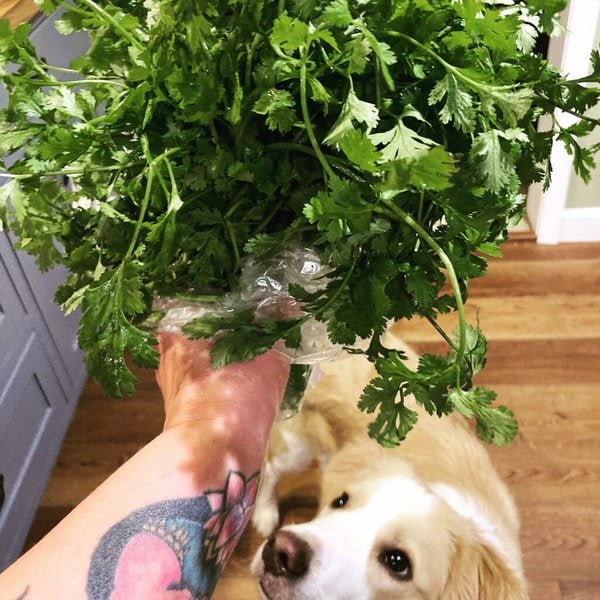
Can Dogs Eat Cilantro Seeds?
Yes, dogs can eat cilantro seeds. These seeds are also called coriander, and they usually have a hard texture when dry. But because the seeds are often harvested dried, they do not provide as many health benefits as the fresh herbs do to dogs.
Cilantro seeds are used as flavors in curry and other spices and are most valuable when dry. Dogs cannot eat this seed without you crushing it for them. And just like the fresh herb, you should sparingly serve this nutty food to your furry companion.
By now, you must be asking yourself about the appropriateness of cilantro roots. Can dogs also eat cilantro roots? I think that question is worth answering.
Can Dogs Have Cilantro Roots?
Yes, dogs can have cilantro roots in moderation as there is nothing toxic about it. However, because the root contains fiber, your pups cannot afford to eat cilantro roots in large quantities so as not to develop stomach upsets.
If you hope to use cilantro as a medicine for your dog, the best parts to use are the leaves, stems, and seeds. The roots are often less appealing to dogs’ taste, and many may not like them. That aside, most cilantro roots become bitter as they mature.
Is Lime-Cilantro Rice Good For Dogs?
No, lime-cilantro rice is not good for dogs. While a taste won’t harm your furry friends, excessive consumption of lime can pose serious health challenges like stomach upset or poisoning to your canine.
Apart from the danger of excessive consumption of lime, giving your dog lime-cilantro rice puts the burden of ascertaining how it was prepared on you. That’s because you would have to ensure that things like garlic, onions, and salts were not part of the ingredients, as they are harmful to dogs.
Now, let’s consider a situation where your pooch has taken any part of coriander without your supervision. What should you do? Is it time for you to visit a vet?
What Should I Do If My Dog Ate Cilantro?
If your dog ate cilantro without your knowledge, relax and watch it for any allergic reaction. Ordinarily, your pooch should not develop any complications because cilantro is not toxic.
However, if you notice any sign of discomfort in your furry friend, you should not hesitate to notify your vet immediately. Some of the signs you should watch out for include:
- Hyperactivity
- Lack of energy
- Weight loss
- Diarrhea
- Vomiting
- Itchy skin
The above are the common allergic responses that dogs display to their food. You don’t need to notice all of them before you act. And one thing you can always do before you receive any professional help is to remove the allergen from your pet.
Again, it is important you know the best way to prepare cilantro for your furry friends. That way, they can maximize all the benefits it has to offer.
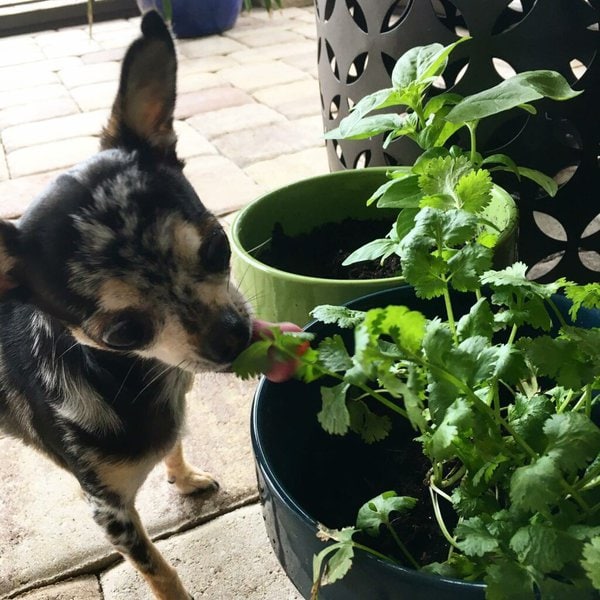
How Do I Serve Cilantro To My Dog?
Cilantros are best served with your dog’s main food and not as a standalone diet. And because this herb is filled with tremendous vitamins and minerals, you have to regulate the quantity you give out to your pup at a time to avoid overdose.
If you are using cilantro seeds or coriander, you first need to crush it into a powder form. After that, take about half a teaspoon of the powder and sprinkle it into your dog’s wet food.
Adding cilantro into your dog’s water requires that you first extract the juice. To do so, you may have to use a blender to crush the leaves or stem and then squeeze out the juice. Remember not to add more than a drop into their water trough.
You can equally serve fresh cilantro leaves to your pooch by dicing a few leaves into a portion of the food you have prepared. One common delicacy that goes with this herb is rice. However, make sure the food doesn’t contain salt or other spices harmful to dogs.
It’s important to start with a very small quantity of cilantro and gradually increase it with time. That way, you can quickly detect if your furry friend likes it or not.

